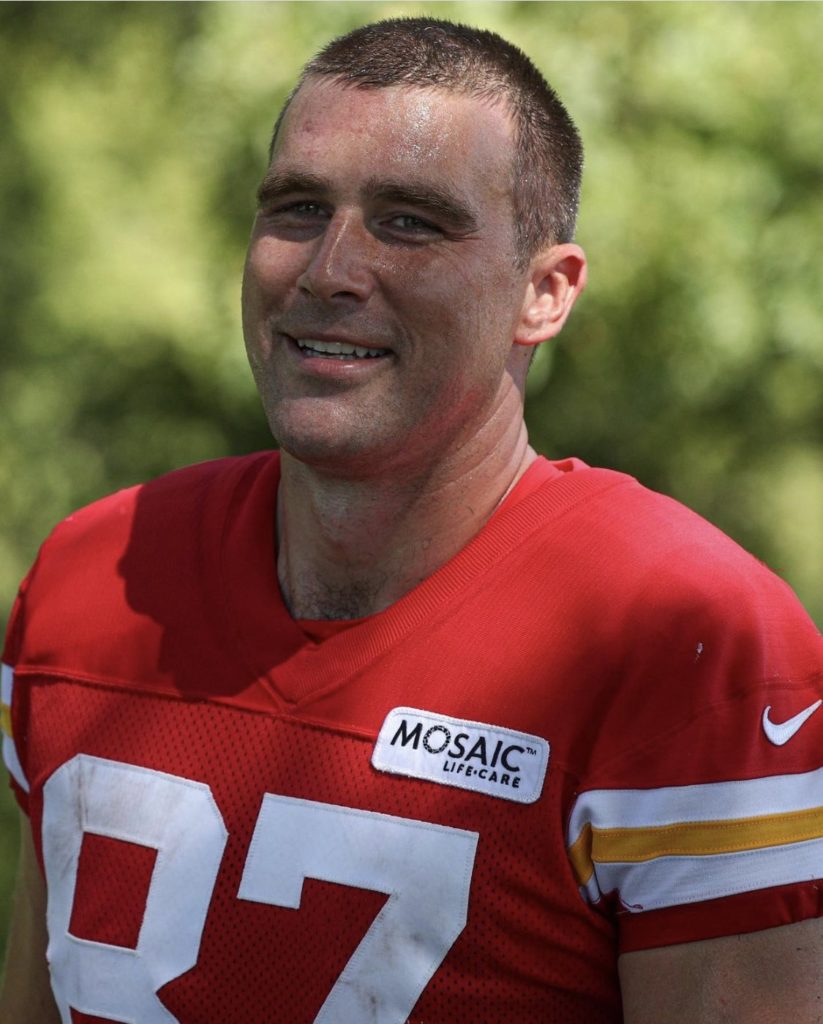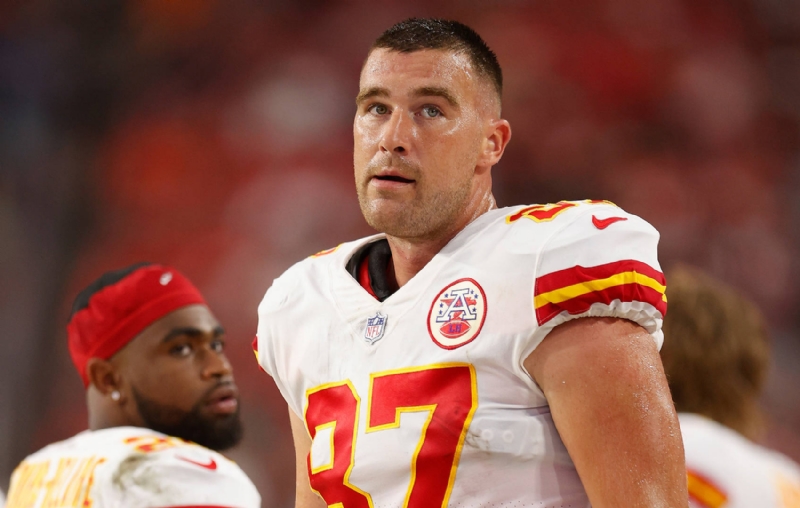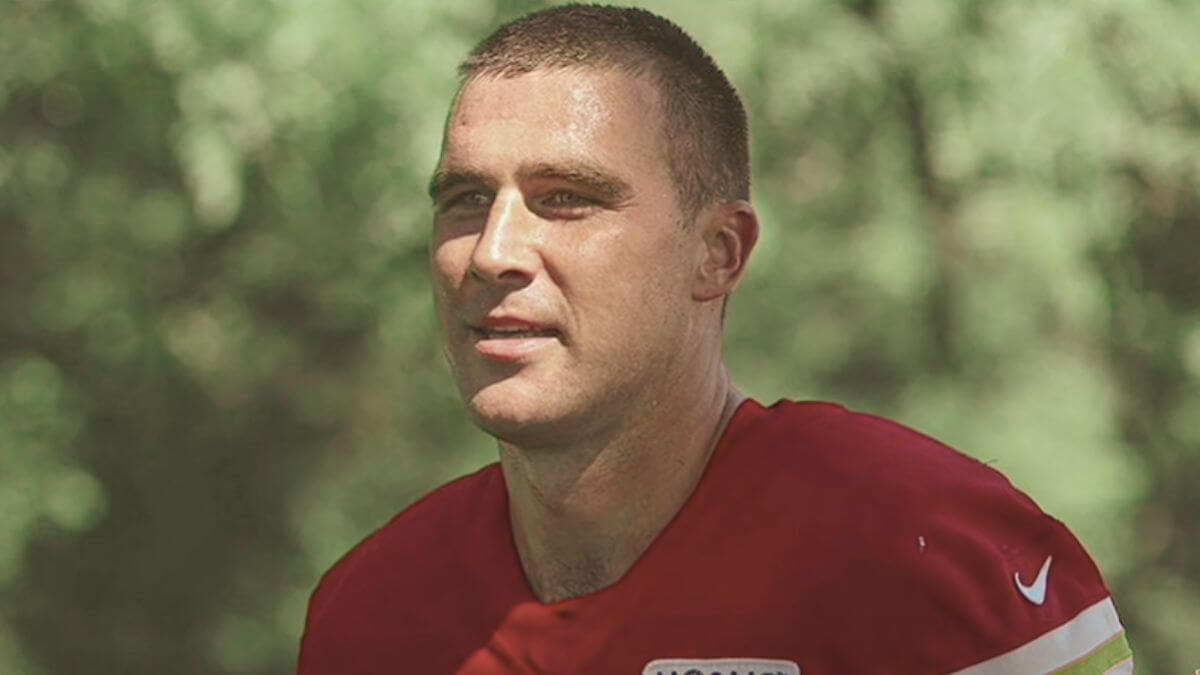What does the absence of a beard signify in the public image of a prominent figure like Travis Kelce? A seemingly minor detail can reveal significant insights into image cultivation and public perception.
The absence of a beard, in the case of a public figure like Travis Kelce, can be analyzed as a deliberate stylistic choice that contributes to a particular image. This choice, made by the individual, directly impacts public perception. It communicates a specific message to viewers regarding personal style, professionalism, and potentially, even personal values or priorities. For example, a clean-shaven appearance may signal an emphasis on a professional and streamlined image, while a more rugged or styled beard might project a different, potentially more relaxed or rebellious image. The context of the moment and individual style should be evaluated.
The choice to shave or not shave can be considered a deliberate strategic element of personal branding. By meticulously controlling visual cues such as grooming, individuals can actively shape how they are perceived by the public. This is true for athletes, actors, and others in the public eye. The absence of a beard may, in the context of Travis Kelce's career, underscore a particular focus on maintaining a polished image that suits his profession as a professional athlete in football.
| Name | Occupation |
|---|---|
| Travis Kelce | American Football Tight End |
Moving forward, the article will delve deeper into the wider context of how public figures manage their public image, exploring the trends, motivations, and possible impacts of such choices.
Travis Kelce's Shaven Face
Analyzing the absence of a beard on Travis Kelce reveals insights into professional image-building. The choice, likely deliberate, communicates a specific message to the public.
- Professionalism
- Image Management
- Public Perception
- Style Consistency
- Athletic Identity
- Branding Strategy
A clean-shaven appearance often aligns with a professional image, crucial for athletes in high-profile sports. Maintaining a consistent style, like no beard, becomes part of a larger branding strategy. Public perception is shaped by visible cues like grooming; a professional athletes image is often presented as polished and consistent. The absence of a beard becomes a visible element in building that athletic persona, influencing how audiences view the player's commitment and presentation. The consistent stylistic choice reflects the calculated nature of image-building in today's media-saturated environment.
1. Professionalism
The absence of a beard in athletes like Travis Kelce often correlates with an image of professionalism. A clean-shaven appearance, in such contexts, can suggest adherence to specific standards of presentation expected within professional sports. The meticulous control of visual cues such as grooming becomes a component of overall professional image management. This connection is not unique to Kelce; many professional athletes curate a specific image, often perceived as consistent with a professional role. The image itself may reflect a dedication to presenting a particular public identity.
Consideration of the context is critical. The perception of professionalism within a particular field often involves specific grooming standards. In professional sports, the presentation of an athlete plays a part in their public image, impacting how fans, sponsors, and the media perceive their dedication and commitment. A perceived dedication to grooming can extend to an interpretation of dedication to other aspects of the role, influencing the perception of professionalism. This is not a universally accepted connection; individual interpretations vary based on personal experiences and expectations of performance. Therefore, the association between a shaved face and professionalism remains a complex one, influenced by context and individual perceptions.
In conclusion, the apparent link between a clean-shaven appearance and professionalism in athletes like Travis Kelce reflects the importance of visual cues in shaping public perception. A carefully curated image, including grooming, communicates a commitment to presenting a specific professional identity within the context of the sport. This understanding, however, should be contextualized; the connection between grooming practices and perceived professionalism isn't universally established, potentially subject to individual interpretation and contextual influences.
2. Image Management
Image management, a crucial component of public perception, plays a significant role in shaping how individuals are perceived. In the case of public figures like Travis Kelce, deliberate choices regarding appearance, including the presence or absence of a beard, are integral to image management. This calculated strategy directly impacts how the public perceives their professionalism, consistency, and overall persona. A clean-shaven look might convey a sense of precision and dedication, aligned with the demands of a professional athlete. Conversely, different grooming styles can communicate alternative messages. The decision to maintain or abandon a beard becomes a tool in conveying a certain image.
The impact extends beyond mere aesthetics. Image management in the realm of professional sports, like football, is often intertwined with public perception and brand building. A player's image can influence fan support, sponsorship deals, and media portrayal. Consistent image presentation reinforces a particular identity, aiding in long-term brand development. For example, consistently maintaining a clean-shaven face can be viewed as part of a player's overall effort to project a focused and professional persona. This consistent visual presentation strengthens the image of reliable performance and professionalism.
Understanding the connection between image management and choices like a shaved face provides valuable insight into the multifaceted strategies employed by public figures to cultivate and maintain a desired image. This approach is not unique to athletes but is relevant across various professions and public figures. The choice to have or not have a beard becomes a strategic decision within the broader context of image cultivation. This understanding is significant because it highlights the calculated nature of public presentations, impacting how individuals interact with and interpret their public figures. While the absence of a beard can be part of a broader strategy to curate a public image, it is essential to recognize the complexities involved in such strategies and their individual motivations. Factors such as personal values and individual interpretation must also be considered.
3. Public Perception
Public perception, encompassing how individuals perceive a person or entity, is a complex phenomenon influenced by various factors. In the context of public figures like Travis Kelce, even seemingly minor details like the absence of a beard contribute to the overall image and influence public perception. This analysis explores facets of public perception relevant to this observation, highlighting how visible cues, like grooming choices, can significantly impact how a person is viewed. The investigation examines how such choices are perceived and interpreted within a broader cultural context.
- Grooming and Professionalism
Grooming choices, including shaving or growing a beard, can be interpreted as indicators of professionalism and adherence to specific standards in a given field. In professional sports, a clean-shaven appearance can be associated with a disciplined approach and dedication to the sport's demands. This perception is not universal; alternative interpretations and individual preferences exist.
- Consistency and Brand Identity
Consistency in presentation fosters a recognizable brand image. A public figure consistently maintaining a specific grooming style, such as no beard, creates a familiar visual representation. This consistency can positively or negatively influence perceptions, depending on the image desired and how it aligns with audience expectations. In the case of a player like Travis Kelce, maintaining a consistent appearance reinforces a professional and reliable image.
- Cultural Context and Personal Style
Cultural interpretations and personal preferences play crucial roles in shaping public perceptions. The meaning assigned to a clean-shaven face varies across different cultures and social groups. Specific grooming practices can be perceived differently depending on the individual's personal style and context, impacting how such choices are interpreted. An individual's image choices are viewed through a lens of cultural interpretation and audience context.
- Media Representation and Interpretation
The media significantly influences how a public figure is perceived. Images of a public figure, including grooming decisions, are often disseminated and interpreted through media outlets. The way a media platform presents a player's appearance, for instance, can influence public opinion regarding their persona. How the media portrays Travis Kelce, encompassing facial hair or its absence, could influence public perception of his character and professionalism.
In conclusion, the absence of a beard on Travis Kelce, when considered within the framework of public perception, reveals the complex interplay between individual choices, cultural interpretations, media representation, and broader societal perceptions. Examining these facets provides a nuanced understanding of how visual cues like grooming significantly influence how a public figure is perceived, shaping the image they project to the world. The perceived meaning of these choices is not inherent to the physical aspect but is, instead, heavily influenced by contextual factors.
4. Style Consistency
Style consistency, a deliberate and recurring pattern in presentation, plays a significant role in the public image of figures like Travis Kelce. The absence of a beard, a consistent grooming choice, is a component of a broader strategy to maintain a particular image. This consistency, when maintained over time, creates a predictable and recognizable persona. This predictability fosters a sense of reliability and professionalism, which can influence various aspects of public perception.
Maintaining a consistent style, including facial hair choices, allows for the development of a recognizable brand identity. This brand identity reinforces a particular image and message. In Travis Kelce's case, a consistently clean-shaven face reinforces a perception of professionalism and attention to detail. Such consistency, when evident in other aspects of presentation, can further solidify this image. Real-world examples abound; successful business leaders often maintain a consistent image, using attire and grooming to communicate professionalism and reliability to stakeholders. Similarly, athletes frequently cultivate an on-field identity, often through carefully curated appearances.
The practical significance of understanding style consistency lies in its impact on public perception. A consistent image cultivates a degree of familiarity and trust. This familiarity can influence various outcomes, including fan support, media portrayal, and potential sponsorship opportunities. In the case of athletes, the consistent presentation of a specific imagein this example, a clean-shaven appearancecan be linked to perceived professionalism and commitment. Maintaining such a consistent style facilitates recognition and brand-building, influencing relationships with fans, sponsors, and colleagues. Conversely, inconsistency in presentation can lead to confusion or uncertainty, potentially undermining the desired image. This analysis highlights the importance of considered choices in creating a cohesive and impactful public image.
5. Athletic Identity
Athletic identity encompasses the multifaceted characteristics that define an athlete's public persona. This includes not just on-field performance but also off-field behaviors, appearances, and values. The deliberate choice to maintain a specific grooming style, like the absence of a beard in the case of Travis Kelce, can be a significant component of cultivating a particular athletic identity. This stylistic choice likely serves to project an image of professionalism, discipline, and commitment to the sport.
The connection between athletic identity and grooming choices like the absence of a beard is not coincidental. Athletes often strive for a consistent and recognizable public image that reflects their dedication and professionalism. The perceived commitment to a specific style, such as maintaining a clean-shaven face, can contribute to a specific athletic identity. A clean-shaven look might be associated with a disciplined approach and adherence to standards within the sport. This association isn't universal; individual interpretations and cultural contexts influence the meaning of such choices. Consideration of other factors, such as the specific sport or league, is essential in understanding the context and significance of these choices. For instance, an athlete in a sport with strict appearance guidelines might favor a more uniform appearance compared to another competing in a more relaxed atmosphere.
Understanding the connection between athletic identity and grooming decisions like the absence of a beard offers practical insights. It highlights the calculated approach athletes often employ to manage their public image and build specific brand identities. This can impact various aspects, from media portrayal and fan perception to sponsorship opportunities and overall professional standing. Examining the choices public figures make, including athletes, regarding their appearances provides a lens into the strategies they employ for image cultivation and how those strategies align with the broader goals of building a strong athletic identity.
6. Branding Strategy
A branding strategy, meticulously crafted, shapes public perception of a figure like Travis Kelce. The absence of a beard, a deliberate stylistic choice, becomes a component within this broader strategy. This choice, often subtle yet significant, contributes to a unified and consistent brand image. Careful consideration of appearance, encompassing grooming choices, is a key aspect of constructing a recognizable brand identity within the realm of professional sports. This meticulously curated image fosters a particular perception amongst fans, sponsors, and the media.
Consider the multifaceted nature of a successful branding strategy. The visual aspects are crucial; a consistently clean-shaven face, for instance, can reinforce an image of discipline, professionalism, and reliability. These qualities are often associated with successful athletes. Real-world examples abound; successful business leaders often maintain a consistent visual identity, using attire and grooming to convey professionalism and reliability. A consistent appearance, whether through clothing or facial hair choices, contributes to brand recognition and memorability. This consistency creates a powerful message, whether it's perceived as steadfast professionalism or a more casual, accessible image. The strategic implications of such decisions are evident in their effect on public perception and potential opportunities, such as sponsorship deals or media coverage.
In conclusion, the connection between branding strategy and a choice like Travis Kelce's no-beard look reveals a calculated approach to image management. The absence of a beard, viewed within this broader context, serves a crucial role in shaping the desired public image. This analysis underscores the intricate relationship between visual cues and the development of a successful brand identity. Understanding this interplay of choice and perception is crucial in navigating the complexities of public image management and building a successful personal brand, especially in a highly visible field like professional sports.
Frequently Asked Questions about Travis Kelce's Facial Hair
This section addresses common inquiries regarding the absence of facial hair in public figures like Travis Kelce. The questions and answers provided aim for clarity and factual accuracy.
Question 1: Why does Travis Kelce maintain a clean-shaven face?
Travis Kelce's grooming choices, including the absence of a beard, likely form part of a broader image management strategy. Maintaining a clean-shaven face might align with professional standards in professional sports. This consistency can signal dedication, professionalism, and a focus on projecting a particular image to the public.
Question 2: Is there a connection between grooming choices and public perception?
Public perception is influenced by various factors. A public figure's grooming choices, including the presence or absence of facial hair, contribute to their overall image. These choices are often interpreted within cultural contexts and expectations. The interpretation can vary from individual to individual and across different contexts.
Question 3: How do grooming choices impact brand identity?
Consistent grooming, including decisions about facial hair, contributes to a recognizable brand identity. A consistent image, often projected visually, can build familiarity and trust. This brand consistency impacts how audiences perceive the figure's professionalism, reliability, and overall image.
Question 4: Are there cultural factors influencing interpretations of grooming choices?
Cultural backgrounds and expectations significantly influence how grooming choices are interpreted. The meaning attributed to specific grooming practices can vary across cultures. Personal interpretations and preferences also impact how these choices are understood.
Question 5: Does the absence of a beard reflect a strategic image management?
In the case of public figures, grooming choices, like the decision to shave or not shave, can be intentional elements of a wider image management strategy. A clean-shaven face can represent a particular aesthetic and reinforce a chosen public image. Strategic decisions regarding image management are often integral to a public figure's success.
In summary, choices about facial hair, like Travis Kelce's clean-shaven appearance, are often nuanced and strategically employed to present a specific image and build a brand identity. These decisions are usually interpreted within a cultural and professional context.
The next section delves into the broader implications of image management for public figures in various professions.
Conclusion
This exploration of Travis Kelce's grooming choices, specifically the absence of a beard, reveals a multifaceted approach to image cultivation. The analysis underscores the deliberate nature of visual presentation in projecting a desired public image. Key findings indicate a link between consistent grooming practices, a professional image, and the construction of an athletic brand identity. The study further highlights how grooming choices are interpreted within specific cultural and professional contexts, affecting public perception. The discussion reveals that such choices are not merely aesthetic but also serve as integral components of strategic image management.
The analysis emphasizes the strategic nature of public image construction. Grooming, as a visible element, can significantly influence how a public figure is perceived, impacting career trajectories, public perception, and brand recognition. Future research could investigate the broader implications of similar choices in other public figures across various professions, exploring correlations between visual cues and perceived professionalism, credibility, and success. The study underscores the importance of considering the complex interplay between individual choices, cultural contexts, and public interpretation in shaping the perception of public figures.


